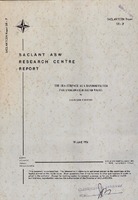| dc.description.abstract | In this dissertation the phenomenon of scattering and reflection of underwater sound waves from the sea surface is studied by considering the surface sound channel as a random, time-dependent filter. This filter can be best analyzed by means of its frequency transfer function, from which another important system function, the impulse response, can be derived as Fourier transform. Starting from the wave equation for an iso-velocity medium with boundary condition of zero total pressure, a formula for the transfer function is found via the Helmholtz integral, by means of Meecham's perturbation technique. It is a six-fold integral that can be reduced to a converging series of surface integrals when the specular angle of incidence is smaller than 84 deg C. The convergence is then even so fast that the leading term is a good approximation for the whole series. Next, the speed of the wind that generates the random sea surface is assumed to be at most 10 m/s, and the relative position of transmitter and receiver is chosen in such a way that the specular angle of incidence does not exceed 84 deg . Numerical analysis of first and second statistical moment of this term then shows that it can be replaced by a simple formula which is identical to the one that follows from the Kirchhoff-Eckart theory. This Kirchhoff-Eckart formula is used for a statistical investigation of the random filter. First and second order moments are calculated under the assumption that the ocean surface is a stationary and homogeneous, but anisotropic, Gaussian process. Frequency, time, and space-correlation functions of the filter output, when delta pulses or harmonic signals are applied at the input, reflect in a simple way the statistical properties in frequency, time, and space of the sea surface, if the roughness parameter \xi is less than one (\xi=2 kh\cos\theta_s). With increasing roughness, this property is gradually lost. These theoretical results are shown to be in agreement with experimental data found in the literature. Hence they can be used to predict the behaviour of the underwater communication channel via the surface, when the surface is characterized by its wave spectrum, or by its spatial and temporal correlation functions. Originally submitted by the author to the Technological University of Twente, The Netherlands (Technische Hogeschool Twente) in fulfilment of a degree of Doctor in Technical Sciences. (Doctor in de technische wetenschappen.) | |
